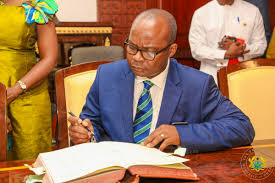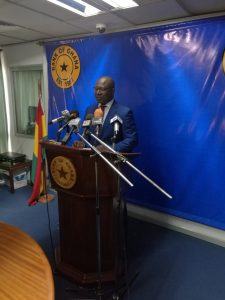
Accra, July 26, 2017//-Economic data on both global and domestic developments that have become available since the last Monetary Policy Committee (MPC) meeting is encouraging.
Below is the excerpts of the Monetary Policy Committee (MPC) press statement read by the Governor and Chairman of MPC of the Bank of Ghana BoG, Dr Ernest Addison on Monday 24 July, 2017.
Global growth momentum is gradually strengthening with continued support from manufacturing, trade and relatively higher commodity prices.
However, the pickup in growth is yet to translate into stronger global inflation dynamics. With subdued inflation across most advanced economies, the pace of monetary policy normalization is expected to be gradual, and this will likely moderate tightening of global financing conditions.
These favourable global developments are expected to impact the domestic economy through the trade and financial channels, with a positive outlook for the balance of payments, exchange rate and inflation.
On the domestic front, consumer price inflation has steadily trended downwards since September 2016 partly due to policy tightness, relative stability in the exchange rate and some favourable base drift effects. Since the last MPC meeting, headline inflation has declined from 13.0 percent in April 2017 to 12.6 percent in May and subsequently to 12.1 percent in June.
In a similar direction, the Bank’s measure of core inflation, which excludes energy and utility price changes from the consumer basket, continued to trend downwards. From 13.7 percent in April 2017, core inflation fell to 13.3 percent in May and further to 12.8 percent in June. The results of the latest surveys conducted by the Bank pointed to further decline in inflation expectations.
These trends in headline, core and inflation expectations suggest dampening of underlying inflation pressures. And the pace of disinflation is consistent with the latest forecast results, which show an unchanged inflation forecast horizon since the beginning of the year.
Inflation is therefore expected to continue on its gradual deceleration path towards the medium-term target of 8±2 percent in 2018. Meanwhile the output gap is beginning to close.
The recently released GDP data from the Ghana Statistical Service showed that the economy expanded by 6.6 percent on a year-on-year basis in the first quarter of 2017, relative to 4.4 percent in the same period a year earlier.
The stronger growth outcome was largely driven by increased crude oil production. However, the non-oil sector growth was weaker turning in at a modest 3.9 percent in the first quarter of 2017, against 6.3 percent recorded for the same period of last year.
The lower non-oil growth continues to reflect low activity in the services sector. Going forward, the policy initiatives outlined in the 2017 budget are expected to help economic activity pick up and result in much improved growth outcomes.
The Bank’s leading indicator of growth, the Composite Index of Economic Activity (CIEA), suggests some pickup in economic activity in the first five months of 2017, relative to the same period last year.
The observed momentum in the CIEA was mainly driven by exports, construction and credit to the private sector. The latest business and consumer confidence surveys, conducted in June, also broadly reflected positive sentiments in the direction of the economy.
While businesses were optimistic about achieving their expectations on sales and profit, consumer sentiments were largely driven by improvement in household incomes and purchases of durables.
Total liquidity measured as broad money supply (M2+) continued to expand on an annual basis driven mainly by the net foreign assets of the banking system. Broad money supply (M2+) grew by 23.7 percent in May 2017 compared to 16.8 percent a year earlier.
On a year-on-year basis, bank credit to the private sector and public institutions increased by GH¢5.1 billion (16.4% y/y growth) compared with GH¢2.5 billion (11.3% y/y growth) for the same period in 2016. Of the total credit flow, the private sector accounted for 86.5 percent.
In real terms, credit to the private sector rose by 3.2 percent in May 2017, against 7.4 percent contraction over the same period last year. The credit conditions survey conducted by the Bank in June 2017, showed some tightening of credit conditions for enterprises and households as banks begin to clean their books and reclassify their loan portfolios following the industry-wide comprehensive asset quality review exercise that ended in December 2016.
Overall, the banking sector remains sound, well capitalized and liquid, however the quality of lending weakened over the last few years with non-performing loans reaching 21.7 percent in May 2017. Following the Asset Quality Review (AQR), the Bank of Ghana has been implementing a roadmap for recapitalization which required the few banks which did not meet the minimum capital adequacy ratio to submit capital restoration plans. The implementation of the roadmap is on course.
Most of these banks have met the minimum requirement and a few are on course to doing so within the stipulated timeframe.
Implementation of the budget for the first four months of the year has remained broadly in line with the set target. Fiscal operations for the year to April 2017 resulted in a cash deficit of 1.5 percent of GDP, within the set target of 2.2 percent, mainly due to expenditure controls even as revenue fell below target.
Provisional data shows that total revenue and grants for January to April 2017 were 5.4 percent of GDP against a target of 6.5 percent. Total expenditures, including arrears clearance was 6.6 percent of GDP compared with a budgeted estimate of 8.3 percent. Financing of the deficit, equivalent to 1.5 percent of GDP was mostly from domestic sources.
The total public debt at the end of May 2017 stood at GH¢137.2 billion from GH¢122.6 billion at end 2016. The total stock of the domestic debt stood at GH¢63.9 billion and the external debt was GH¢73.3 billion. The increase in the debt stock was on account of issuance of long-dated domestic bonds in line with government’s debt management strategy of re-profiling the public debt as well as extending the yield curve.
Meanwhile Ghana’s external position at the end of June 2017 has improved in line with medium-term macroeconomic fundamentals. Developments in the trade account over the first half of 2017 reflected higher export receipts arising from increased production volumes in gold, cocoa and crude oil.
The recovery in exports combined with declining imports, resulted in an estimated trade surplus of 3.1 percent of GDP, compared with a trade deficit of 3.3 percent recorded last year.
Provisional estimates of the balance of payments for the first quarter of 2017 indicated a current account surplus of US$317 million (0.7% of GDP), a turnaround from the current account deficit of US$577 million (1.4% of GDP) in the same period of 2016. The capital and financial account however recorded a net outflow of US$523 million (1.1% of GDP) due to lower official inflows which offset the current account surplus. These developments resulted in a slightly improved overall balance of payments deficit of US$390 million (0.8% of GDP) compared with the deficit of US$449 million (1.1% of GDP) a year ago.
Foreign exchange market conditions remain stable supported by improved liquidity conditions, the trade surplus and increased reserves.
In the year to June 2017, the Ghana cedi recorded a depreciation of 3.7 percent against the US dollar, compared with a depreciation of 3.3 percent reported in June 2016.
Gross International Reserves stood at US$5.9 billion, translating into 3.4 months of import cover at end June 2017, compared with US$4.9 billion (2.8 months of import cover) at end December 2016.
The Outlook and Risks
In sum, the Committee noted that economic activity continued to improve supported by a rebound in crude oil production, and is expected to remain in line with trends seen in the first half of the year.
The Bank’s CIEA also provides some positive indications of expected increased momentum in economic activity. The broad expectation is that the gradual and steady increases should translate to higher growth profile in the period ahead.
In addition, implementation of fiscal policy measures towards providing stimulus through the key initiatives contained in the 2017 budget statement should provide added impetus to growth.
The disinflation process is still ongoing and this trend is likely to continue all through till the end of the third quarter. Barring any unanticipated shocks, the current stance of monetary policy and expected stability in the exchange rate should ensure price stability. In the outlook, expectations are for the observed decline in headline inflation to continue and converge towards the medium-term target in 2018.
Given these considerations, the Committee decided to reduce the Monetary Policy Rate by 150 basis points to 21 percent.
The Committee would continue to monitor risks and take the necessary policy action to move headline inflation towards the medium term target.
African Eye Report




